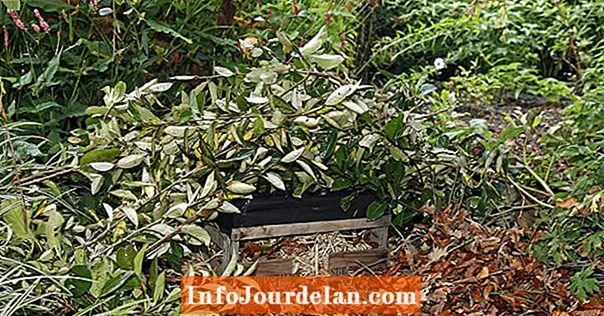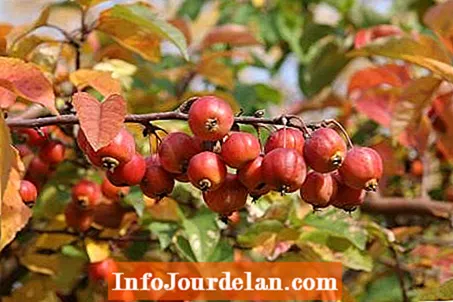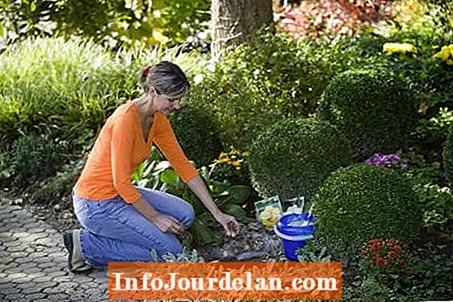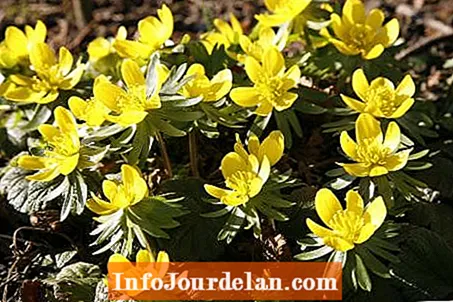
Sowing the lawn, dividing perennials or fertilizing roses: in our gardening tips for the ornamental garden in September you will find the most important tasks at a glance.

When summer is slowly coming to an end, it is time again to prepare the garden for the golden autumn. From lawn care to hedgehog quarters - we have summarized the most important gardening tips for the ornamental garden in September for you.
Hedgehogs start looking for suitable winter quarters from September. If you want to accommodate the useful animals in your garden, you should build suitable winter quarters for hedgehogs for them by September at the latest. Lay out dry leaves or straw in a sheltered spot under bushes and place an upturned fruit crate on top after removing one of the two narrow side walls. In front of this opening, put a few curved willow branches in the ground so that an approximately 30 centimeter long arcade is created as an access. Finally, litter the entire construction with dry branches and leaves - and the quarters are ready.
Some perennials are so exhausted when they bloom that their guest appearance in the garden is short-lived. These include, for example, the cockade flower (Gaillardia). With her, a strong pruning in early autumn has proven to be a life-saving measure. The same applies to the small and large-flowered girl's eye (Coreopsis lanceolata or grandiflora), which, in contrast to the needle-leaved species (Coreopsis verticillata), are naturally short-lived. Admittedly, it is difficult to cut the named candidates close to the ground as early as the end of September, because some of them will then still bloom. But in this way the plants are encouraged to put all their strength into the wintering organs instead of the flowers, and get through the cold season better.
When the temperature drops, the lawn should be mowed to a height of five centimeters: If the grass is longer, it can rot, if it is too short, the roots lack protection against the cold. Leaves that have already fallen can be conveniently picked up at the same time. After all, if left too long, it also promotes putrefaction. This weakens the lawn and makes it more susceptible to gray mold and other fungal diseases. Ventilate small, waterlogged areas with a digging fork, then the roots will get what they need again: oxygen, water and nutrients.
Ornamental apples are visually different from conventional apples. But they are not poisonous, as is often erroneously claimed. On the contrary: Ornamental apples contain a lot of fruit acid and therefore taste tart when eaten fresh from the tree. However, cider or jelly made from ornamental apples is a highly aromatic culinary delight. So there is nothing wrong with extending the apple harvest to the little relatives in the ornamental garden.

It is best to fertilize your roses again with a low-chloride potassium fertilizer such as Patentkali from the beginning to mid-September. The potassium promotes the lignification of the shoots and is stored in the cell sap of the plant cells. There, like de-icing salt, it lowers the freezing point and makes the rose shoots more frost-resistant.

If you have ordered new flower bulbs in good time, you will often receive the delivery from mid-September. It is best to get the fresh onions into the ground straight away - they should be planted about twice as deep as they are tall. A special garden tip: For tulips, lilies and other species that are sensitive to moisture, you should sprinkle some coarse construction sand into the planting hole before planting the onion.
Video: Planting tulips vole-proof
Anyone who struggles with voles in the garden should rather plant their bulbs in a wire basket that is vole-proof. In our video we show you how to do this.
Voles really like to eat tulip bulbs. But the onions can be protected from the voracious rodents with a simple trick. In this video we will show you how to plant tulips safely.
Credit: MSG / Alexander Buggisch / Producer: Stefan Schledorn
In the case of the lily tail (Eremurus), as steppe candles are also called, there is a persistent rumor that they must be set in August. It is often very warm then and the spider-like tubers are not even available. According to Bernd Schober, owner of the flower bulb dispatcher of the same name, the perennial plants also develop splendidly in the classic autumn planting from September to November. A sunny place with nutritious, well-drained soil is important. On heavy soils, fine gravel or coarse sand improve the drainage of water. The planting pit is dug so that the steppe candles are about 15 centimeters deep in the ground and the fleshy, brittle roots can be easily spread out.
Biennial flowers such as the foxglove (Digitalis purpurea) or the yellow poppy poppy (Meconopsis cambrica) sow themselves in favorable locations in the garden and appear in different places in the bed every year. If you are not satisfied with the rate at which your two-year-olds will reproduce, you can now help a little: Collect the seeds at the beginning of September and sow them again in different gaps in the bed. Before doing this, you should roughen the soil a little with a rake and, after sowing, press the seeds gently into the soil with your foot. If it is dry, it is best to pour it on carefully.
In September the last brood of tits, sparrows, nuthatches and wrens flew out. However, there is often still a lot of activity in the nest box, as bird fleas, mites and ticks have also made themselves comfortable here. But that's not the only reason why you should clean the nesting boxes immediately. The Naturschutzbund Deutschland (NABU) points out that cleaning later in autumn could disturb winter guests worthy of protection such as bumblebee queens or bats. Tip: Before you take action with gloves and a broom, please knock. Sometimes there are "intermediate tenants" like wood or dormouse. New nesting boxes can also be hung up now because birds like to use them as shelter on cold autumn and winter days.

Cut the withered flowers of your dahlias continuously above the first or second leaf below the inflorescence, because then the stems will keep producing new buds until the first night frost puts an end to the flowering spectacle. For the vase, you should only cut fully bloomed flower stems - preferably early in the morning. Leave as many leaves on the stems as is absolutely necessary for aesthetic reasons, because too many leaves reduce the shelf life in the vase.
Depending on the weather, the first deciduous trees lose their leaves as early as the end of September. Our garden tip: Cover your garden pond with a leaf protection net at an early stage so that the leaves do not fall into the pond and enrich it with digested sludge.
The beginning of September is the ideal time to sow new lawns. The summer drought is usually over and the soil is still warm enough for the grass seeds to germinate quickly.

The roughly pea-sized, knobbly tubers of the Winterlings (Eranthis) do not suggest that they will turn into pretty spring bloomers. In fact, they need pH-neutral or calcareous garden soil and a sunny to partially shaded place. Here the tubers go five centimeters deep into the ground. Tip: To make sure that winterlings also take root in slightly dry soil, the tubers are placed in water overnight before planting.

Would you like to share your lady's mantle? To do this, simply cut off the soil around the plant with a spade. Then stick deep under the bush, lift it out together with a generous root ball, place it on a free piece of bed nearby and first divide it in half. Then cut off other pieces with a spade, knife or hands. Attention: These should be at least the size of a fist. The "young plants" can immediately find a place in the bed again. It is important that the perennials are well pressed and watered thoroughly. The planting distance should be 30 to 40 centimeters.
A rigorous pruning of the short flower-bearing shoots is necessary in order to preserve the lush flowering of flowers in wisteria without the up to eight meter high plant becoming gigantic. In your wisteria, cut all side shoots back to 30 to 50 centimeters about two months after flowering. If new shoots arise from this, break them out before they lignify. This slows down growth and stimulates the formation of flower buds.

You should transplant evergreen conifers and deciduous trees by September at the latest. They hardly evaporate any more water and will form new roots in the still warm soil by winter. Please note, however, that the plants are still more susceptible to frost damage in the first winter, so it is better to postpone the transplanting of sensitive species such as camellias to spring.
So that your chrysanthemums bloom particularly profusely in autumn, our garden tip is: Overly dense buds must be thinned out. Just pinch out some buds with your fingers. If you only leave one bud per shoot end, the flowers will be particularly large and lush.